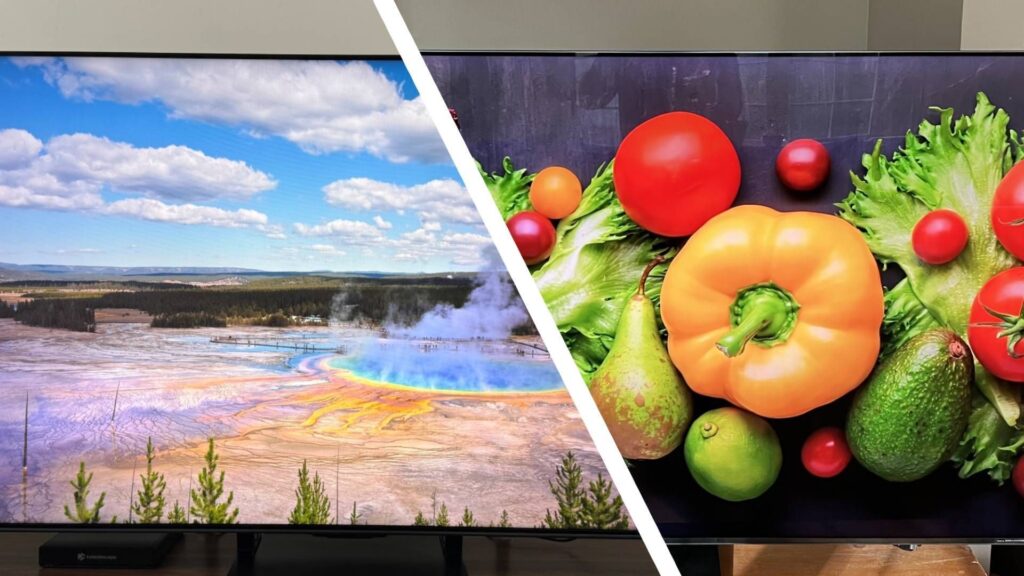The Mini-LED TV market has become increasingly competitive, with brands offering feature-packed models at tempting prices. In 2025, two brands in particular have had a breakout year: TCL and Hisense.
Both have produced some of the best TVs TechRadar has recently tested, including the mid-range Hisense U75QG and TCL QM7K.
(A note for readers in different regions such as the UK: The Hisense U75Q’s closest model is the Hisense U7Q Pro, and for the TCL QM7K it’s the TCL C7K/Q7C. These TVs have some differences but share the same fundamental technology and features.)
You may like
Today’s best deal in the US
Today’s best deal in the UK
Brightness
Image 1 of 2
Hisense U75QG (1) and TCL QM7K (2)(Image credit: Future)(Image credit: Future)
Both the Hisense and the TCL boast high brightness for a TV in their price range. That means they’re both great for bright rooms, which can be a challenging viewing environment for some sets such as the best OLED TVs.
When we measured the TCL’s brightness, it hit 1,733 nits peak in Filmmaker Mode and 2,350 nits in Standard mode. Those are impressive numbers, but when we measured the Hisense, its results were even more remarkable. The Hisense U75Q hit 2,911 nits peak brightness in Filmmaker Mode and 3,372 nits in Standard mode. Those results are staggeringly high for a mid-range TV and actually beat some flagship mini-LED TVs such as the Sony Bravia 9 (which hit 1,871 nits in Filmmaker Mode when we measured it).
Fullscreen brightness is an important factor for countering screen reflections in bright rooms, and here again, the Hisense came out on top, hitting a peak of 887 nits in Standard mode compared to the TCL’s 640 nits. So, if brightness is what you most want in your TV, the Hisense is the winner.
General picture quality
Image 1 of 2
Hisense U75QG (1) and TCL QM7K (2)(Image credit: Future)(Image credit: Future)
The overall picture quality of mid-range mini-LED TVs has been steadily improving with each year. Crucially, contrast and black levels are getting better, as we discovered with both the Hisense U75QG and TCL QM7K.
During testing, both TVs demonstrated strong contrast in dark outer space scenes from Gravity and the many high contrast scenes in The Batman. Both also delivered deep, rich blacks and minimal backlight blooming in comparison to previous generations, although the TCL proved more effective at this.
You may like
Both TVs also demonstrate great color reproduction. During my testing of the TCL, it delivered vivid, bold colors, as seen in the pink flowers in a tree Elphaba stands under in Wicked, and the colors of a vase that Ember fixes in Elemental.
In contrast, we found that colors on the Hisense “left a little to be desired.” When watching shows in HDR, we commented that “skin tones were undersaturated” and “grass was a bit yellow.” For SDR sources, however, the Hisense TV’s colors were extremely accurate.
Both TVs deliver excellent picture quality for the money, with powerful contrast and detailed blacks, so you won’t be let down by either. That said, the Hisense does have a brightness advantage, though the TCL has a color advantage when watching movies and shows in HDR. Ultimately, it really is neck and neck between these two TVs when it comes to picture quality.
Gaming
Image 1 of 2
(Image credit: Future)(Image credit: Future)
Both these TVs really shine when it comes to gaming features. The TCL has two HDMI 2.1 ports that support 4K 144Hz, FreeSync Premium Pro, Dolby Vision gaming and ALLM. That’s an impressive list at this price range.
The Hisense takes things up a notch, however, with four HDMI 2.1 ports that support 4K 165Hz, full VRR (HDMI forum, FreeSync Premium Pro and G-Sync), Dolby Vision gaming and ALLM. It even supports 1080p 288Hz for PC gaming.
Our input lag measurements are good for both the Hisense and TCL, with both clocking below the 15ms threshold gamers look for. However, the TCL measured 13.5ms, and the Hisense 9.8ms, a result that rivals the best gaming TVs from LG and Samsung and puts it on top again.
We did find in our Hisense testing that there was some smearing when playing PC games with VRR activated, “particularly with bright objects across dark backgrounds.” Meanwhile, the TCL TV’s picture during gaming was “sharp and vibrant,” and we didn’t notice any smearing. So, while the Hisense may be the better featured gaming TV, that VRR issue is something for PC gamers to take note of.
Which TV should you buy?
Image 1 of 2
(Image credit: Future)(Image credit: Future)
Both the Hisense U75QG and TCL QM7K are excellent value for money. For the 65-inch models we tested, you’ll be looking to pay $899 on average for both TVs, though we’ve seen them drop to $799 before. In the UK, the 65-inch Hisense U7Q Pro is currently priced at £899, whereas the TCL C7K/Q7C is £789, making the TCL the better deal of the two.
Which one should you buy? Realistically, you won’t be let down by either TV, but if I had to pick one, it would be the Hisense U75Q (Hisense U7Q Pro) thanks to its higher brightness and better gaming features.
The best TVs for all budgets
Our top picks, based on real-world testing and comparisons
Follow TechRadar on Google News and add us as a preferred source to get our expert news, reviews, and opinion in your feeds. Make sure to click the Follow button!
And of course you can also follow TechRadar on TikTok for news, reviews, unboxings in video form, and get regular updates from us on WhatsApp too.
Other Hisense and TCL mini-LED TVs

